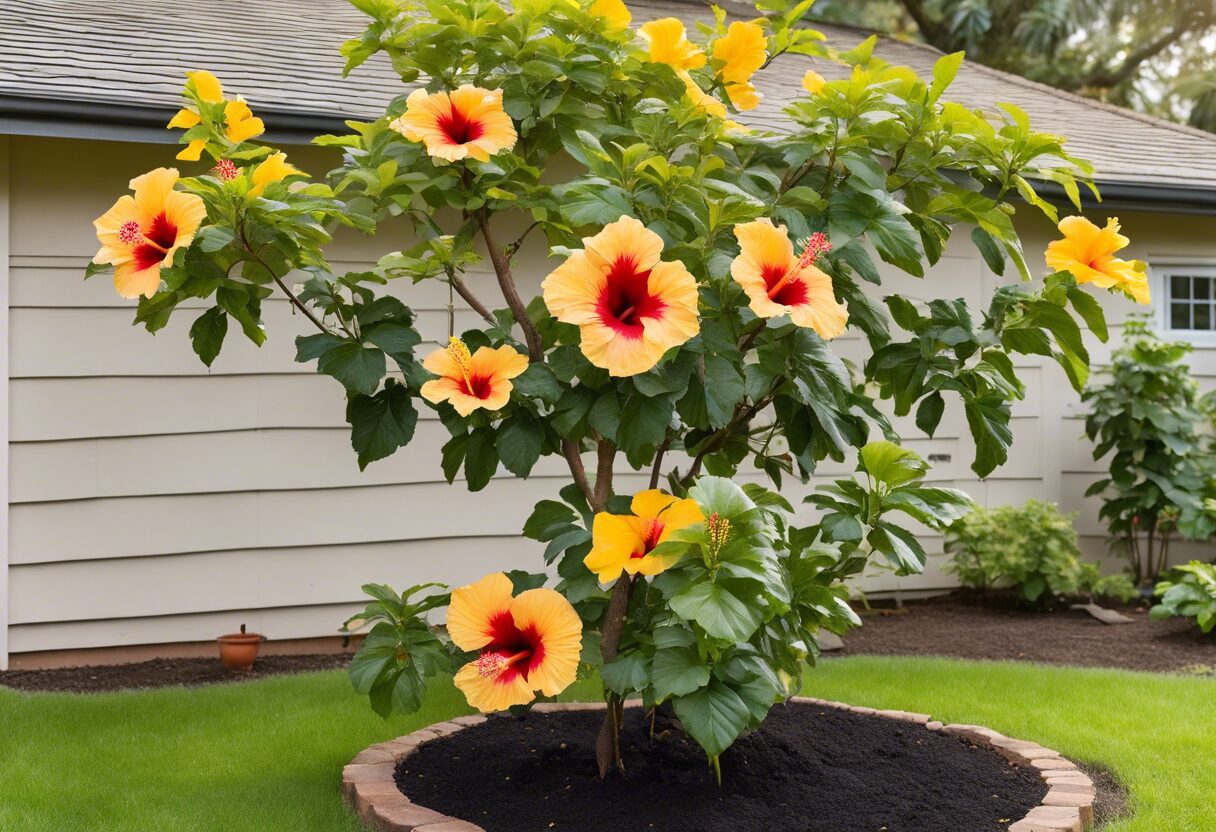Ever had a hibiscus tree that looked more like a Halloween prop than the vibrant, tropical beauty it’s supposed to be? Yeah, been there, done that. But don’t worry, I’ve got good news for you. It’s not too late to Bring a Hibiscus Tree Back to Life.
In this blog post, we’ll walk through the steps of reviving your wilted or dying hibiscus tree and turning it into the envy of your neighborhood. So buckle up plant lovers, because we’re about to embark on a botanical rescue mission! Keep reading about ‘How to Bring a Hibiscus Tree Back to Life?’
Key Takeaways
- Identify the problem with your hibiscus tree, such as pests, diseases, or poor watering habits.
- Improve its environment by ensuring it gets enough sunlight and is in a well-draining soil.
- Regularly water the hibiscus but avoid overwatering. The soil should be kept moist but not soggy.
- Use a balanced fertilizer to provide necessary nutrients.
- Prune dead or diseased branches to promote new growth.
- Monitor the plant’s progress and adjust care as needed.
Understanding the Hibiscus Tree
Let’s get to know our subject a bit better, shall we? We’re talking about the hibiscus tree here. It’s more than just a pretty face with its vibrant flowers. This tree has some unique hibiscus tree characteristics that make it stand out in the plant world.
What is a Hibiscus Tree?
A hibiscus tree, my dear reader, is not your average backyard shrub. It’s an exotic beauty known for its large, colorful blooms. The features of hibiscus tree include glossy leaves and flowers that can be as big as your hand! Now that’s something you don’t see every day.
But wait, there’s more! The attributes of hibiscus tree extend beyond its physical appearance. These trees are also known for their resilience and ability to withstand different weather conditions. So if you’re thinking about getting one, rest assured it won’t give up on you easily!
Common Types of Hibiscus Trees
Now onto the fun part – exploring the different types of these beauties! There are several common hibiscus trees you might come across in nurseries or gardens.
First off, we have the tropical hibiscus. This one is a showstopper with its bold colors and large blooms. Then there’s the hardy hibiscus which, as its name suggests, can handle cold temperatures like a champ.
Each type has its own distinguishing characteristics of hibiscus trees, making them unique in their own right. Whether it’s flower color, leaf shape or size, each type brings something different to the table!
Ideal Growing Conditions for a Hibiscus Tree
So how do you keep this floral diva happy? Well, providing the ideal conditions for hibiscus growth is key. These trees love the sun, so make sure they get plenty of it.
They also prefer well-drained soil. So if you’re planting one in your garden, ensure the area doesn’t collect water. And remember, a little bit of TLC goes a long way in helping to bring a Hibiscus Tree back to life!
As for temperature, these trees are not fans of the cold. They prefer warmer climates and can be sensitive to frost. So if you live in a colder region, consider growing your hibiscus indoors or provide some protection during winter.
Now that we’ve covered the basics, let’s dive deeper into how to revive a struggling hibiscus tree!
Identifying Problems with Your Hibiscus Tree

To bring a hibiscus tree back to life, you gotta first play detective. Yup, you heard it right! You need to identify the hibiscus tree problems early on. This involves looking out for signs of an unhealthy tree, common diseases and pests, and environmental stress factors.
Recognizing Signs of an Unhealthy Hibiscus Tree
So, how do you spot an unhealthy hibiscus? Well, if your hibiscus is wilting faster than ice cream in the sun or its leaves are turning yellow like a vintage photograph, then Houston, we have a problem. These are classic unhealthy hibiscus signs that shouldn’t be ignored.
Now, don’t just stand there scratching your head wondering what’s up with your plant. It’s time to dig deeper into the issue. Could it be pests? Or perhaps some nasty disease? Let’s find out!
Common Diseases and Pests Affecting Hibiscus Trees
Hibiscuses can be quite the drama queens when it comes to diseases and pests. They’re prone to all sorts of issues – from fungal infections to aphid infestations.
If you notice black spots on leaves or a sticky residue (yuck!), these could be signs of hibiscus diseases or pests affecting hibiscus like aphids. And trust me, these little buggers can wreak havoc on your plant’s health.
Environmental Stress Factors for Hibiscus Trees
Environmental factors can also cause your hibiscus tree to throw a fit. Temperature fluctuations might make it shiver or sweat excessively (yes, plants can sweat too!).
Improper watering is another biggie – overwatering is like making your plant wear wet socks all day (eww!) and under-watering is akin to making it cross the Sahara desert. Both can cause environmental stress on hibiscus.
And don’t even get me started on cold damage. If your hibiscus is exposed to frost, it might just give up on life altogether! So, keep an eye out for these issues if you want to bring a hibiscus tree back to life.
Reviving a Wilted or Dying Hibiscus Tree
Hey there, green thumb! So, your hibiscus tree is feeling a bit under the weather? No worries, we’ve got some hibiscus tree revival tips to bring a hibiscus tree back to life. It’s all about proper care and love!
Adjusting Watering Techniques for Healthier Growth
First things first, let’s talk water. Your hibiscus is like Goldilocks – it doesn’t want too much or too little water. Overwatering can drown its roots while underwatering leaves it parched. Look out for yellow leaves or wilting – these are classic overwatering symptoms and underwatering signs. Adjust your hibiscus watering techniques accordingly to promote that healthy growth.
The Role of Sunlight in Reviving Your Hibiscus Tree
Next up, let’s shine some light on the situation. Sunlight plays a big role in the health of your hibiscus tree. These beauties need plenty of light but not scorching heat. Aim for bright but indirect sunlight – think of it as their version of a beach holiday! Remember, getting the optimal sunlight for hibiscus is key in reviving your plant.
Importance of Proper Pruning to Stimulate Growth
Last but definitely not least, grab those pruning shears! Pruning isn’t just for looks; it helps stimulate new growth and keeps your plant healthy. So don’t be shy – give your hibiscus a good trim every now and then. With these proper pruning techniques for hibiscus trees, you’ll be well on your way to seeing that vibrant bloom again!
Nutrient Management for a Healthy Hibiscus Tree
To bring a hibiscus tree back to life, you gotta understand its nutrient needs, choose the right fertilizer, and master proper fertilization techniques. This is key in maintaining a healthy hibiscus.
Understanding the Nutrient Needs of a Hibiscus Tree
Hibiscus trees are like us humans, they need specific nutrients to thrive. Nitrogen, phosphorus, and potassium are their main squeeze. These essential nutrients for hibiscus help with growth and blooming.
But that’s not all! They also crave minor nutrients like magnesium and iron. Without these, you might face nutrient deficiency in hibiscus trees. So remember folks, understanding what your plant needs is the first step to keeping it happy!
Choosing the Right Fertilizer for Your Hibiscus Tree
Now comes the tricky part – picking out the perfect grub for your green buddy. When selecting hibiscus fertilizer, look for one that’s high in potassium and low in phosphorus.
Why? Well, this combo helps promote those gorgeous blooms we all love! But don’t forget about those minor nutrients I mentioned earlier. A good rule of thumb is to pick a balanced fertilizer – something like a 10-10-10 or 20-20-20 will do just fine.
And remember folks, always read those labels! It can be confusing but understanding fertilizer labels for hibiscus is crucial to make sure you’re giving your tree exactly what it needs.
When and How to Fertilize Your Hibiscus Tree
Alrighty then! Now that we’ve got our grub sorted out, let’s talk about when and how to feed our leafy friends. The best time for fertilizing hibiscus trees is during their growing season, which is typically from spring to fall.
As for the how, you’ll want to apply your fertilizer evenly around the base of the tree. But be careful not to overdo it! Over-fertilization can cause more harm than good.
Remember, it’s all about balance. With the right fertilization technique for hibiscuses, you’ll have a healthy and blooming tree in no time!
Dealing with Diseases and Pests in Your Hibiscus Tree
When it comes to bringing a hibiscus tree back to life, dealing with diseases and pests is crucial. It’s like being a plant doctor, diagnosing hibiscus tree diseases and prescribing the right disease treatment. But don’t worry, you’ve got this! We’ll dive into two main areas: common diseases and pest management.
Treating Common Diseases in a Hibiscus Tree
First things first, let’s talk about disease identification. Look out for yellowing leaves or black spots – these are telltale signs of disease. Now, onto hibiscus tree treatment. You might need to use fungicides or bactericides depending on the disease type.
But hey, prevention is better than cure, right? So, focus on disease prevention as well. Regularly check your plant for any early signs of disease and nip them in the bud (pun intended!). Remember, proper hibiscus tree care can go a long way in keeping those pesky diseases at bay.
Managing Pests that Harm the Health of Your Hibicus Tree
Now let’s tackle those creepy crawlies harming your hibiscus. Identifying them is step one in effective pest management. Look for chewed leaves or tiny bugs crawling around – these are red flags for an insect infestation.
Next up is treatment. There are various pest treatment methods, from insecticidal soaps to more eco-friendly options like introducing beneficial insects who’ll eat up the harmful ones (talk about natural justice!).
And finally, prevention strategies! Keep your plant healthy and less attractive to pests by maintaining good hygiene and regular pruning. After all, we want our hibiscus trees healthy and blooming again!
To Wrap Up
In the grand dance of nature, bringing a hibiscus tree back to life is like teaching an old dog new tricks. It’s all about patience, love, and proper care.
For more tips on how to Bring a Hibiscus Tree Back to Life, don’t hesitate to dig deeper into our resources. Remember, every plant can have its second spring!


